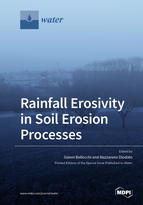Rainfall Erosivity in Soil Erosion Processes
A special issue of Water (ISSN 2073-4441). This special issue belongs to the section "Water Erosion and Sediment Transport".
Deadline for manuscript submissions: closed (31 December 2019) | Viewed by 33665
Special Issue Editors
Interests: climate history; geostatistics; hydrological modelling; precipitation extremes; soil erosion; water resources management
Interests: agricultural and environmental climatology; biogeochemical fluxes; hydro-meteorology
Special Issues, Collections and Topics in MDPI journals
Special Issue Information
Dear Colleagues,
The challenges that soils are facing today imply that aspects related to the intensifying precipitation cycle, such as rainfall erosivity, cannot be ignored. Large portions of land in the world are exposed to multiple damaging hydrological events. They include destructive phenomena like landslides and floods, which cause disruption to people and goods. Climate and land-use changes are the primary causes of accelerated soil erosion, which has substantial implications for macro- and micro-nutrient transformations in soils and water, and for the control of terrestrial carbon feedback. Data and modelling approaches are still scarce on how changes in the spatial and temporal features of rainfall patterns influence the magnitude and timing of erosive storms, which in turn results in changes in the landscape response.
There appears to be rich potential for innovative research for variable spatial and temporal scales at the interface between geomorphology, hydrogeology, and ecology. This Special Issue plays a major emphasis on the landscape–rainfall interplay as a dynamic concept. We call for contributions that explore (i) how erosive rainfall and soil erosion respond to climatic variability and human activity, and (ii) how such changes explain the changes in carbon and nutrient pools (and their spatial heterogeneity) in terrestrial and water systems. We welcome contributions providing evidence that changing precipitation regimes are altering the risk and magnitude of landscape changes. Contributors are encouraged to show how current process studies can extend the historical erosion records, while unravelling the complex interactions between internal landscape dynamics, human impacts, and changes in precipitation regimes. Contributions should also aim consider issues of land‐use management in addressing the changes and geomorphic process regimes that extreme precipitation can trigger. They should illustrate how climate change impacts can be disentangled from other controlling factors, thereby contributing to debates over societal adaptation to extreme rainfalls towards developing more resilient, less vulnerable socio‐geomorphological systems.
Dr. Nazzareno Diodato
Dr. Gianni Bellocchi
Guest Editors
Manuscript Submission Information
Manuscripts should be submitted online at www.mdpi.com by registering and logging in to this website. Once you are registered, click here to go to the submission form. Manuscripts can be submitted until the deadline. All submissions that pass pre-check are peer-reviewed. Accepted papers will be published continuously in the journal (as soon as accepted) and will be listed together on the special issue website. Research articles, review articles as well as short communications are invited. For planned papers, a title and short abstract (about 100 words) can be sent to the Editorial Office for announcement on this website.
Submitted manuscripts should not have been published previously, nor be under consideration for publication elsewhere (except conference proceedings papers). All manuscripts are thoroughly refereed through a single-blind peer-review process. A guide for authors and other relevant information for submission of manuscripts is available on the Instructions for Authors page. Water is an international peer-reviewed open access semimonthly journal published by MDPI.
Please visit the Instructions for Authors page before submitting a manuscript. The Article Processing Charge (APC) for publication in this open access journal is 2600 CHF (Swiss Francs). Submitted papers should be well formatted and use good English. Authors may use MDPI's English editing service prior to publication or during author revisions.
Keywords
- climate variability
- hydrogeomorphology
- land management
- landscape response
- rainfall erosivity
- soil erosion







